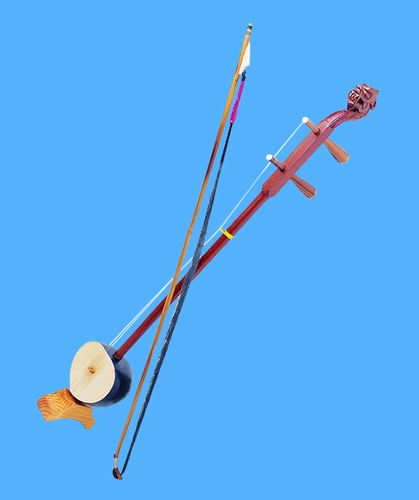Classification of banhu
Banhu, a kind of stringed instrument, has a history of more than 300 years in China and has various names, such as Qin Hu, Huhu, Bangzihu, Daxian and so on. The timbre is high, firm, and has strong penetrating power. It is the main accompaniment instrument for northern opera and rap, and can also be used for ensemble and solo.

According to the pronunciation of banhu and the range of use, it can be roughly divided into the following three types:
1. High-pitched banhu (commonly known as Bangzihu, Daxian or scoop) is mostly used in Hebei Bangzi, Pingju, Henan Opera, Shandong Bangzi, Lv Opera, Errenzhuan, etc. Northeast and North China operas, singing and dancing, singing, solo and ensemble, etc. This kind of banhu is used for the widest
2. The alto banhu is mostly used for accompaniment, instrumental ensemble and solo in Shanxi and Northwest operas, such as Qin Opera, Pu Opera, Ji Hu, Long Opera, Shaanbei Daoqing, Lanzhou Guzi, etc. The speaker is larger than the high-pitched hu, semi-circular in shape, with a money flower hole on the back, and the piano bar is also longer.
3. The tenor banhu (commonly known as coconut hu) is mostly used in Jin opera and Shangdang Bangzi. The speakers are slightly larger than the midrange board, and are also carved with money flower holes. The tuning is a minor third or a perfect fourth lower than the alto banhu. The timbre is rich and the volume is grand, suitable for playing slow, low tunes.
After the founding of the People's Republic of China, the banhu has been continuously reformed, and now there is a kind of midrange banhu, which uses steel strings instead. Banhu has become an ensemble and solo instrument from an accompaniment instrument.
1. For the solo banhu, the barrel and panel are larger, 8-10 cm in diameter, the bar is thicker than that of the erhu, 70-73 cm in length, the outer strings use steel strings, the inner strings use silk strings, or all steel strings are used. The timbre is thick and soft, and can be played in a higher position.
2. Treble Banhu, also known as "Hebei Bangzi Banhu" or "Pingju Banhu". The shape is slightly smaller than the solo banhu, and the pronunciation is high-pitched, sharp and bright, and it is suitable for the accompaniment of Hebei Bangzi and Pingju. The scoop used for accompaniment of Hebei Bangzi is larger, and the scoop used for accompaniment of Pingju is smaller.
3. Alto Banhu, also known as "Henan Bangzi Banhu". The length of the piano is 70 cm, the diameter of the panel is 8.5-9.5 cm, the pegs are thick, the outer strings are ordinary old strings, and the inner strings are thick old strings.
4. Banhu in Qin Opera, also known as "Huhu". The barrel is made of larger coconut shells, and the strings are made of old strings, which are lower in pronunciation than the previous types of banhu, and are mainly used as accompaniment for Qin Opera.
5. Shanxi Banhu, also known as "Jinzhong Banhu". The barrel is larger than that of the Qinqiang Banhu, and the stem is thicker. The bow stem is made of bamboo board with a width of 3 cm. The outer strings are old strings, and the inner strings are wound or casing strings. The timbre is rich and the volume is grand, and it is suitable for playing slow and low tunes. It is the main accompaniment instrument of Shanxi Bangzi.
In addition, there is a banhu with the same structure as the Jinghu, but the barrel is slightly larger and not covered with snake skin. Both the stem and barrel are made of bamboo, and the pronunciation is crisper than other banhus. Province is extremely popular.
6. Shuangqianjin Banhu, inspired by Shuangqianjin Erhu. It changed the original waist horse to a camel, and played the role of supporting and balancing the pressure of the strings, increasing the effective string length, and extending the range of fifths downward. Under the camel horse, there is a movable jin that can move up and down, and a transfer jin is added below the movable jin. The double-jin base is placed in the piano bar and can slide up and down. Banhu device is very convenient for tuning after this kind of activity, the sound range reaches three and a half octaves, the sound quality is soft and beautiful, and it has the timbre characteristics of high-pitched banhu and mid-range banhu, which enriches Banhu's playing skills and ability to perform.
7. Sanxian Banhu, a new variety of Banhu successfully developed in the late 1970s. The lower end of the piano bar is bent in a bow shape and is inserted obliquely into the piano barrel. The headstock is the same as the three strings, and it is flat shovel-shaped. The pegs (2 on the left, 1 on the right) are arranged on both sides. The jins are made of mahogany and are in the shape of an oblique trapezoid, which is convenient for the strings to be arranged at equal distances. The bridge is a bamboo ladder tripod, and the three strings are placed on steps of different heights. On the top, the bow is drawn outside the strings, and it can play two notes, chords and simple polyphonic melody.
According to the different characteristics of music in different places, banhus are used in different sizes. For example, the banhus used in music in northern Shaanxi are slightly larger; those in Hebei and northeast regions are all smaller in size.
 渝公网安备 50010702504639号
渝公网安备 50010702504639号